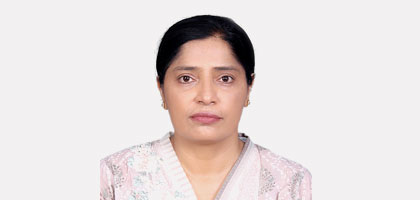Faculty Achievement View More Faculty Achievements

Recognition
Dr. Lubna Naz, Dr. Khadija Bari and Dr. Junaid Alam Khan
IBA faculty members secured the distinguished Demographic and Health Surveys (DHS) Fellowship awarded by USAID
Dr. Lubna Naz, Assistant Professor, School of Economics and Social Sciences (SESS); Dr. Khadija Bari, Director, Population Research Centre; and Dr. Junaid Alam Khan, Director, Talent Hunt Programs; secured the distinguished Demographic and Health Surveys (DHS) Fellowship awarded by the United States Agency for International Development (USAID).
The DHS Fellowship is highly competitive and granted to those whose research proposal meets the strict criteria of novelty, clarity, and alignment with the United Nations’ Sustainable Development Goals relating to maternal and child health.
We congratulate Dr. Lubna Naz, Dr. Khadija Bari and Dr. Junaid Alam Khan on this remarkable achievement and wish them success in their future endeavors.
Published Works
Dr. Lubna Naz
IBA faculty co-authors a paper on nutritional inequalities among children under-five
Dr. Lubna Naz, Assistant Professor, Department of Economics, School of Economics and Social Sciences (SESS) , has co-authored an article titled, 'Nutritional inequalities among under-five children: a geospatial analysis of hotspots and cold spots in 73 low- and middle-income countries', published in International Journal for Equity in Health.
Abstract:
Background:
Child undernutrition is a severe health problem in the developing world, which affects children’s development in the long term. This study analyses the extent and patterns of under-five child undernutrition using Demographic and Health Surveys (DHS) for 73 low- and middle-income countries (LMICs).
Methods:
First, we mapped the prevalence of undernutrition in the developing world. Second, using the LISA (a local indicator of spatial association) technique, we analyzed the geographical patterns in undernutrition to highlight the localized hotspots (regions with high undernutrition prevalence surrounded by similar other regions), cold spots (regions with low undernutrition prevalence surrounded by similar other regions), and outliers (regions with high undernutrition surrounded by low undernutrition and vice versa). Third, we used Moran’s I to find global patterns in child undernutrition.
Results:
We find that South Asia has the highest under-five child undernutrition rates. The intra-country nutritional inequalities are highest in Burundi (stunting), Kenya (wasting), and Madagascar (underweight). The local indicator of spatial association (LISA) analysis suggests that South Asia, Middle East and North Africa (MENA) region, and Sub-Saharan Africa are undernutrition hotspots and Europe and Central Asia and Latin America, and the Caribbean are undernutrition cold spots (regions with low undernutrition surrounded by similar other regions). Getis Ord-Gi* estimates generally support LISA analysis. Moran’s I and Geary’s C gave similar results about the global patterns of undernutrition. Geographically weighted regressions suggest that several socioeconomic indicators significantly explain child undernutrition.
Conclusions:
We found a significant within and across country variation in stunting, wasting and underweight rates among the under-five children’s population. The geospatial analysis also suggested that stunting, wasting, and underweight patterns exhibit clear regional patterns, underscoring the need for coordinated interventions at the regional level.
The article can be accessed here.
